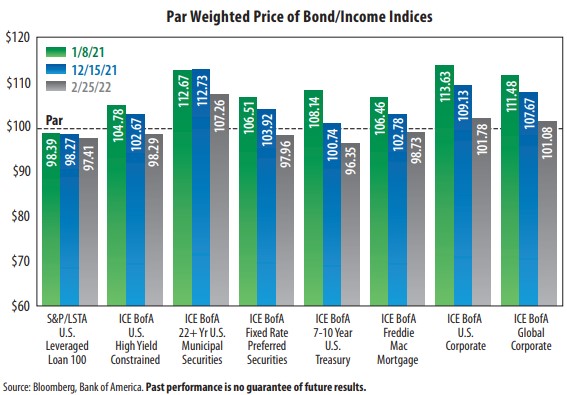
View from the Observation Deck
1. Today's blog post is one we do ongoing so that investors can monitor fluctuations in bond prices relative to changes in interest rates. The dates in the chart are from prior posts.
2. The Federal Reserve ("Fed") has kept the federal funds target rate (upper bound) at 25 basis points (bps) since March 2020 (just after onset of COVID-19).
3. For the 30-year period ended 2/25/22, the federal funds target rate (upper bound) averaged 2.50%, according to Bloomberg. It reached as high as 6.50% in May 2000.
4. The yield on the benchmark 10-year Treasury note (T-note) rose from 1.12% at the close on 1/8/21 to 1.96% at the close on 2/25/22, or an increase of 84 basis points,
according to Bloomberg. Its average yield was 4.00% for the 30-year period ended 2/25/22.
5. For comparative purposes, here were the closing yields as of 2/25/22 for the indices featured in the chart: 4.25% (U.S. Leveraged Loan 100); 5.80% (U.S. High Yield
Constrained); 3.63% (22+ Yr. Municipal Securities); 4.86% (Fixed Rate Preferred Securities); 1.96% (7-10 Yr. U.S. Treasury); 2.61%% (Freddie Mac Mortgage); 3.25%
(U.S. Corporate ); and 2.72% (Global Corporate), according to Bloomberg.
6. As indicated in the chart, the price declines in the 7-10 Year U.S. Treasury Index and the U.S. Corporate Index were clearly the most dramatic between 1/8/21 and 2/25/22.
7. The trailing 12-month Consumer Price Index (CPI) rate stood at 7.5% in January 2022, according to the Bureau of Labor Statistics. That is up significantly from its 1.4%
level in January 2021 and its 2.3% average rate over the past 30 years.
8. In addition to the multiple rate hikes expected from the Fed this year as well as the potential for inflation to trend higher, bond investors will also need to monitor the
war between Russia and Ukraine to see what impact it may have on energy prices and the global economy. Stay tuned!



